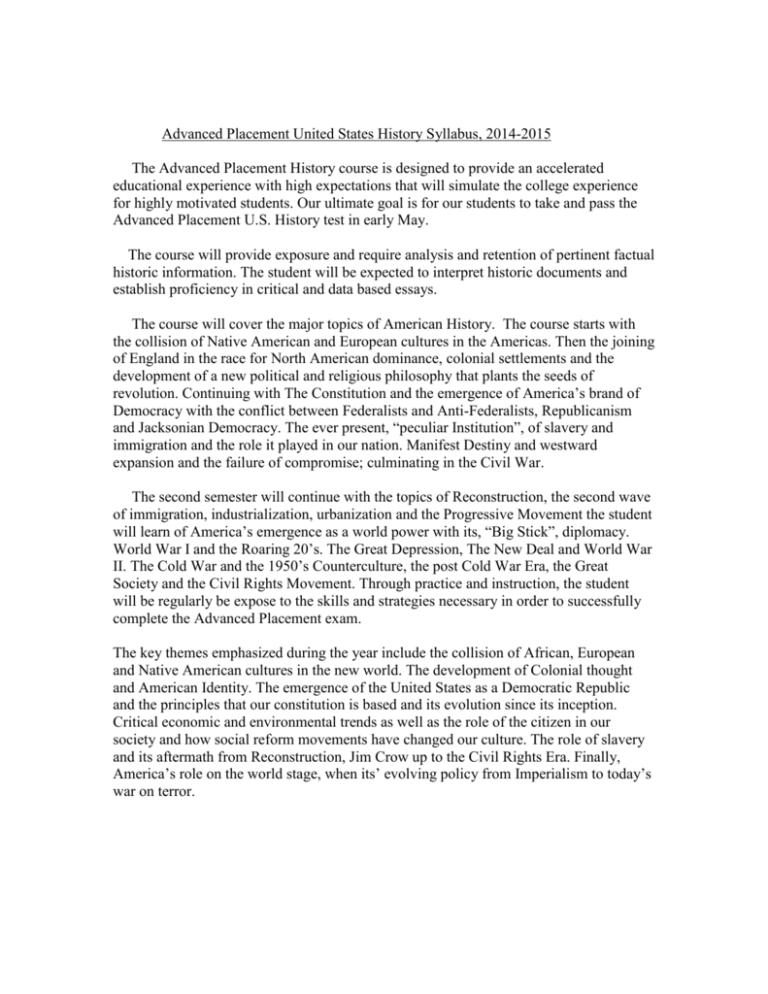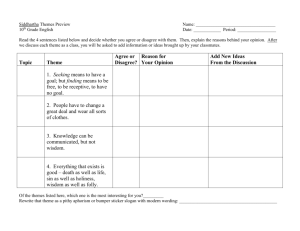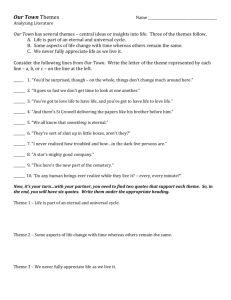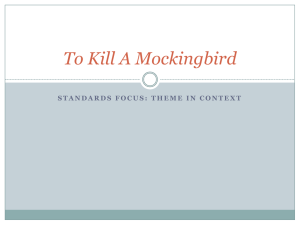AP US History
advertisement

Advanced Placement United States History Syllabus, 2014-2015 The Advanced Placement History course is designed to provide an accelerated educational experience with high expectations that will simulate the college experience for highly motivated students. Our ultimate goal is for our students to take and pass the Advanced Placement U.S. History test in early May. The course will provide exposure and require analysis and retention of pertinent factual historic information. The student will be expected to interpret historic documents and establish proficiency in critical and data based essays. The course will cover the major topics of American History. The course starts with the collision of Native American and European cultures in the Americas. Then the joining of England in the race for North American dominance, colonial settlements and the development of a new political and religious philosophy that plants the seeds of revolution. Continuing with The Constitution and the emergence of America’s brand of Democracy with the conflict between Federalists and Anti-Federalists, Republicanism and Jacksonian Democracy. The ever present, “peculiar Institution”, of slavery and immigration and the role it played in our nation. Manifest Destiny and westward expansion and the failure of compromise; culminating in the Civil War. The second semester will continue with the topics of Reconstruction, the second wave of immigration, industrialization, urbanization and the Progressive Movement the student will learn of America’s emergence as a world power with its, “Big Stick”, diplomacy. World War I and the Roaring 20’s. The Great Depression, The New Deal and World War II. The Cold War and the 1950’s Counterculture, the post Cold War Era, the Great Society and the Civil Rights Movement. Through practice and instruction, the student will be regularly be expose to the skills and strategies necessary in order to successfully complete the Advanced Placement exam. The key themes emphasized during the year include the collision of African, European and Native American cultures in the new world. The development of Colonial thought and American Identity. The emergence of the United States as a Democratic Republic and the principles that our constitution is based and its evolution since its inception. Critical economic and environmental trends as well as the role of the citizen in our society and how social reform movements have changed our culture. The role of slavery and its aftermath from Reconstruction, Jim Crow up to the Civil Rights Era. Finally, America’s role on the world stage, when its’ evolving policy from Imperialism to today’s war on terror. Text book: Kennedy, David M., Lizabeth Cohen, and Bailey Thomas. American Pagent. 13th ed. Boston, Mass.; Houghton Mifflin Co., 2006. Resource Book: Moran, Margret., Holder, Francis., Peterson’s Master A.P. U.S. History. 2nd Edition. Nelnet. U.S.A.2005. Grading: Homework 10% Tests 90% LATE WORK IS NOT ACCEPTED… THIS IS A COLLEGE COURSE Week Of: 9/2-9/5 Review Summer Readings Pass in Summer Outlines Activity, Understanding the challenges of governing, Autocracy vs. Democracy. 9/9-9/12 Chapter 7. The Road to Revolution. Themes: A. England’s change in Colonial policy from Salutary Neglect to Mercantilism. B. Taxation Without Representation. C. The American and British advantages and disadvantages as the Revolution starts. Activity. Students complete a timeline on ten important political events leading up to the American Revolution between 1763-1776. Test Practice. Describe and Explain Essays. 9/12 Read Chapter 8. 9/115-9/19 Chapter 8. America Secedes from the Empire. Themes: A. The Declaration of Independence. It’s inspiration and impact. B. The conditions and circumstances that led to a Colonial victory in the Revolutionary War. C. The terms of The Treaty of Paris. Test Practice. Multiple Choice; Quotation Questions 9/19 Read and outline Chapter 9. 9/22-9/25 Chapter 9. The Confederation and the Constitution, 1776-1790. Themes: A. The Colonies move to a more equal and Democratic society. B. The role of compromise in the development of the Constitution C. The Constitution and its’ design for a strong central government. Debate: Should the U.S. adopt the new Constitution to replace the Articles of Confederation? 9/25. Read Chapter 10. 9/29-10/3 Chapter 10.Launching the new Ship of State. Themes: A. The Addition of the Bill of Rights to the Constitution. The challenges faced by the Washington Administration. B. The evolution of the Hamilton Federalists and the Jefferson Anti-Federalists. C. The election of 1800 and Washington’s Farewell Address. Test Practice. Who? What? When? Where? Why? How? Essay questions. 10/3 Read Chapter 11. 10/6-10/10 Chapter 11. The triumphs and travails of the Jefferson Presidency. Themes: A. The early political developments of the new republic. B. The emergence of the Judicial Branch. C. Foreign diplomatic missteps lead to a division in America between Western War Hawks and New England Doves. D.B.Q. #2 Thomas Jefferson and Philosophical Consistency, 1790-1809. 10/10 Read Chapter 12. 10/14-10/17 Chapter 12. The War of 1812. The Second War for Independence and the upsurge of nationalism. Themes. A. After the War of 1812, America turns to isolationism. B. The war left a strong sense of Nationalism in America. C. The continued emergence of John Marshall’s Supreme Court. Test Practice: Multiple Choice Questions, How? Why? Cause and Effect. 10/17 Read Chapter 13. 10/20-10/24 Chapter 13. The Rise of Mass Democracy. 1824-1840 Themes: A. Jacksonian Democracy. B. The emergence of a second American political party system. C. The problems of tariffs, the economy and Indian Policy and other issues faced by Andrew Jackson. Test Practice. In What Ways? Essay Questions. 10/24 Read Chapter 14. 10/27-10/31 Chapter 14. Foraging a New Nation. Themes: A. Expansion of slavery in the West and displacement od Native Americans. B. Acquisition of new natural resources. C. Strained relations with Mexico, improved relations with England and trade relations with Asia. Analyze. The student will listen and analyze three different pieces of music. * Sweet Betsy From Pike, ( traditional folk song; History Alive! TCI) * Wind River, ( Andrew Vazquez/ Apache song; Putomayo World Music) * LaBamba, ( traditional Mexican song and dance: Los Lobos. Test Practice. Multiple Choice Questions, Maps. 10/31 Read Chapter 15. 11/3-11/7 Chapter 15. The ferment of Reform and Culture. Themes: A. The Second Great Awakening and the role of women in reform movements. B. The new spirit of reform affects most areas of American culture, especially with a new anti-slavery crusade. C. Education and the arts make gains in America. D.B.Q. #3 The Changing Place of Women. 11/7 Read Chapter 16. 11/12-11/14 Chapter 16. The South and the Slave Controversy. 1763-1860. Themes: A. Slavery becomes more entrenched with the increased demand for cotton. B. The abolition movement causes a pro slavery backlash in the South and a anti-slavery sentiment in the North. Debate. Is slavery an intolerable institution? 11/14 Read Chapter 17. 11/17-11/21 Chapters 17&18. Manifest Destiny and Renewing Sectional Struggle. Themes: A. After victory over Mexico and Western land acquisitions the U.S. gains international prestige in growing contrast to growing distrust among Latin American countries. B. The question of slavery after the Mexican American War was quelled with the Compromise of 1850 but erupted with the Kansas/Nebraska Act of 1854. C. The 1850’s Westward and Caribbean expansion divide the country as it is tied to slavery. 11/21 Read Chapter 19. 11/24-11/25 Chapter19. Drifting Toward Disunion. Theme: A.To study the formation of political parties leading up to the election of 1860. B. The election of Abraham Lincoln causes even states to secede from the union and form the confederate states of America. Interpretation. Students will compare, contrast and interpret Presidential Electoral Maps. Carnes and Garraty, The American Nation: A History of the United States. 2006. A-19 to A-31. D.B.Q.#4 Slavery and Sectional Attitudes, 1830-1860. 11/25 Read Ch 21. 12/1-12/5 Chapter 21 The Furnace of the Civil War. 1861-1865 Theme A. The Civil War started as a conflict over the Union and developed into a war to end slavery. B. The Union Army under the leadership of Ulysses Grant wears down the South and brings about an end to slavery. Test Practice. Charts and Graphs, Multiple Choice Questions. 12/5 Read Chapter 22. 12/8-12/12 Chapter 22. The Ordeal of Reconstruction 1865-1877 Theme: A. The results of military reconstruction on the South, leaving a deep legacy of racial and regional tension. B. The Constitution’s new 14th and 15th amendments as well as its testing with the impeachment of Andrew Johnson. C. Southern resistance to reconstruction and the formation of hate groups such as the K.K.K. Test Practice D.B.Q.#5 12/12 Read Ch 23 12/15-12/19 Chapter 23. Political Paralysis in The Gilded Age. Theme: A. Politics during the Gilded Age was mired down in “spoils” and ineptitude. B. With the depression of 1893 farmers call for economic change. C. The Compromise of 1877 ends Reconstruction forcing blacks and poor whites into sharecropping. Jim Crow laws further segregate and persecute African Americans. 12/19 Read Chapter 24. 1/5-1/9 Chapter 24. Industry Comes of Age. Theme: A. With the Transcontinental Railroad, American business grew and formed giant trusts. B. Industrialization changed the conditions for the American worker. To improve conditions workers attempt to unionize causing conflicts between labor and management. C. Moral questions arise as great wealth is in the hands of a few. Were the wealthy obligated to reach out to the poor? D.B.Q.#5 The Role of Capitalists. 1/9 Read Chapter 25 1/12-1/15 Chapters 25. America Moves to the City. Theme: A. The urban immigrant explosion leads to unpre3cedented urban poverty. B. African Americans suffer as the south is slower to develop. Booker T. Washington and W.E.B. Du Bois offer African Americans two different views on how enfranchisement may be achieved. 1/15 Read Chapter 26 1/20-1/23 Chapter 26.The Great West and Agricultural Revolution Theme: A The conquest of the Indians. B. The Industrialization of Agriculture. C. Workers in Revolt 1/23 Read Chapter 28 or 29 1/26-1/30 Chapters 28&29. Progressivism of Roosevelt and Wilson. Theme A. Progressivism gained success at the state and city level. Under Roosevelt it gained national prominence. B. After winning a three way election Wilson pushes through a program of domestic and social reform. C. Wilson’s progressive foreign policy fails as tensions rise in Latin America and Europe. Test Practice. The Compare and Contrast Essay. 1/30 Read and outline Chapter 30. 2/2-2/6 Chapter 30. The War to End All Wars. Theme: A. As a result of Germany’s submarine warfare and the Zimmerman telegram the United States enters W.W.I. Wilson moves the country toward a greater volunteer effort in order to prepare for war. B. Wilson tries to develop the peace with his Fourteen Points. With European opposition and senatorial obstruction his peace plan fails as the U.S. rejects the Versailles Treaty and The League of Nations. Debate: Should the United States ratified the Treaty of Versailles and joined the League of Nations? D.B.Q.#6 The United States as a world power. 2/6 Read and outline Chapter 31. 2/9-2/13 Chapter 31. The Roaring 20’s Theme: A. After W.W.I. America drifted to isolation in foreign policy affairs, social conservatism and an emergence of a youth culture. B. Changes in moral values produced cultural divisions and changes in literature and the arts that had a lasting impact. Test Practice. Essay, Defending a position. 2/13 Read and outline Chapter 32. 2/16-2/20 Chapter 32. The Politics of Boom or Bust. 1920-1932 Theme: A. The Republican administrations of the 1920’s conservative economic policies oversaw unprecedented economic growth. B. The crash of 1929 led to a devastating world wide depression, heightened by Herbert Hoover’s inability to handle it. Activity: Research and interpret the election results of 920 and 1924. http://www.uselectionatlas.org/RESULTS/national.php?f=0&year=1920 Test Practice. Multiple Choice Questions: Cartoons and Photographs 2/20 Read and outline Chapter 33. 3/2-3/6 Chapter 33. The Great Depression and The New Deal. Theme: A. Roosevelt’s New Deal attempts to attack The Great Depression with massive federal programs to bring about relief, recovery and reform. 3/6 Read and outline Chapter 34. 3/9-3/13 Chapter 34. F.D.R. And The Shadow of War. Theme: A. For the first half of the 1930’s the United States adopted a policy isolation. B. The spread of totalitarianism and the war in Europe forces Roosevelt to support Great Britain. Debate: Isolation vs. internationalism. Should the U.S. move away from isolationist neutrality and toward aiding the allies in the fight against Hitler? Test Practice. Multiple Choice, The Value of Sources. 3/13 Read and outline Chapter 35. 3/16-3/20 Chapter 35. America in W.W.II. Theme: A. Outraged by Pearl Harbor, the U.S. mobilizes militarily, socially and economically. B. Following its, “ Get Hitler First”, strategy the U.S. and it’s allies “Island Hopping”, successful but slower abruptly ends with the dropping of the atomic bomb. Test Practice. D.B.Q.#7 Foreign Policy 1930-1941. 3/20 Read and outline Chapter 36. 3/23-3/27 Chapter 36. The Cold War Begins. Theme: A. America realizes an economic boom after W.W.II. With a growth In population many move to the suburbs and the Sun Belt Leaving urban areas to minorities and the poor. B. The Soviet Union and the U.S. become the world’s two dominate Powers and become engaged in the Col War. Test Practice. Review Essays. 3/27 Read and outline Chapter 37. 3/30-4/3 Chapter 37 The Eisenhower Era. Theme: A. The Civil Rights Movement emerges as does T.V. and popular Music. 4/3 Read and outline Chapter38. 4/6-4/10 Chapter 38. The Stormy 60’s. Theme A. President Kennedy’s “flexible response” doctrine leads to conflict While confronting communism in third world countries. B. Liberal and social reform led by the Civil Rights movement And Great Society are overshadowed by the turmoil of the Vietnam War. Activity: Simulate the December 1969 selective Service Lottery. Test Practice. Multiple Choice, Vocabulary questions. 4/10 Read Chapter 39 4/13-4/17 Chapter 39. The Stalemated Seventies Theme A. Economic Stagnation B. Nixon and Vietnam C. Watergate 4/17 Read Chapter 40 4/20-4/24 Chapter 40. The Resurgence of Conservatism Theme A. The “New Right” B. The end of the Cold War C. The Persian Gulf War. 5/4 – 5/8 Prepare and Review for AP Exam Exam Date May 8, 2015 Updated: July 2015





